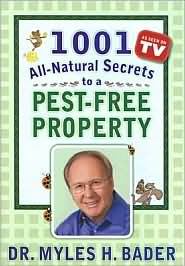
Last week I took a look at old, out of print books that are worth finding and reading. This week I think I’ll take a slightly different track and instead turn my attention to a book that is currently in print, but which shouldn’t be. In fact, 1001 All-Natural Secrets to a Pest-Free Property by Myles H. Bader can be found in many bookstores, was actually one of the best selling garden books of 2006, and is still selling today. There are other books that I have problems with (Jerry Baker comes to mind) but when considering the worst of the worst this book is all by itself.
I was first introduced to Dr. Bader (he reportedly has a doctorate in Preventive Care from Loma Linda University) one night when I couldn’t sleep. He was on one of those “paid programming” shows talking about homemade cures for insects around the house. Normally these half-hour long advertisements cure my insomnia, but not this time. As someone who loves to learn about and test homemade remedies I was mesmerized by his recommendations and quickly ordered the book. Sure, on the show he seemed to “dumb things down” a little, but here was a bonafied professor who might have some really cool stuff for me to look at! I couldn’t wait.
After I received the book I discovered that Dr. Bader used the English language poorly. This didn’t turn me off to the book though. I’m pretty forgiving of bad English. I know that mine isn’t the best and there are sections in all of my books which still haunt me. Still, the sheer number of errors in Bader’s book was staggering. For example, here’s a paragraph from page 3: “His interests have always been in the field of food and cooking and many of his books are related to helping the chef or cook with cooking and kitchen secrets that may gave been forgotten over the years. This has lead him to include household hints and other related subjects in his books.” (yes, the words gave and lead are used in the book exactly as they appear above). And this is just the first page with a significant amount of writing!
Still, I didn’t buy this book for good editing; I bought it for cool, “all-natural” cures. And so I turned the pages hoping to find something useful. On page 23 I discovered that the insecticide “Sevin” is organic and is composed of pyrethrums and diatomaceous earth (This is completely wrong, the active ingredient in Sevin is carbaryl, a synthetic insecticide). I also learned, on the same page, that mixing horse manure with hot water, letting the mixture cool, and then spraying it onto fire ants will kill them (What!?!!?). There are no instructions about how much of the manure or hot water to use. Other interesting remedies that you should probably avoid include spraying hairspray onto flies to kill them and using a mixture of 1/3 cow manure, 1/3 sand, and 1/3 clay to coat the trunk and branches of a tree infested by aphids (I’m not sure how this would work since most aphids attack the leaves of trees…). At the end of the book there is a glossary where I learned that Rotenone is a low toxicity poison (never mind that this organic poison was recently voluntarily withdrawn by its makers for use as an insecticide at least in part because of safety/health concerns). Indeed, almost every organic pesticide was treated lightly, apparently simply because they’re “natural” (which, as some of you may know, is a pet peeve of mine).
The interesting thing about this book is that there were a few useful tips, but with so much hooey it was often tough to tease those tips out. If you’re one of those people who thinks that a book can be so bad that it’s good then you might enjoy paging through this book, but, other than that, I think this book is best used as a doorstop.
And now I have a challenge for all of you. Does anyone know of a worse book? (and, if so, where can I buy a copy?)
Whoo hoo! You go Jeff! I hadn't heard of this one, though I can tell it will have to join the aforementioned JB books on my bookshelf of shame. I do have another interesting one to post but it will have to wait until I take a photo of it later today. I would be willing to be that you have never seen, or ever heard, of the botany book I will share with you later….
I think your guy got some concoctions from Lodeman's "The Spraying of Plants" book from 1896 you mentioned before. Another fun read is "Secrets of the Soil" by Peter Tompkins and Christopher Bird including biodynamic preparations using cow parts, cosmic forces and bismuth towers to improve soil health and crop yields. I haven't finished it yet but the interesting claims abound.
Oh yes, biodynamics! I did a myth column on this a few years back and got pulled into an ongoing debate among wine afficianados, some of whom are fervent BD believers. Organic practices just aren't sexy enough, I guess. And you can charge a lot more for a BD wine than an organic one…
What's wrong with better living thru chemistry? If I ever saw bugs in my house like that then I WANT chemicals, traps,etc. There's nothing like the smell of DDSevin on cool September morn. I mean come on, you can rub a lemon behind your ears but I'm spraying down with some Off.